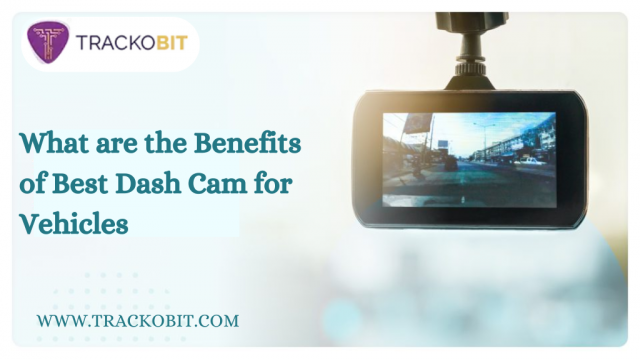Best Dash cam for vehicles, short for dashboard cameras, are used for managing and operating commercial fleets. They enhance safety and efficiency by continuously recording video footage of the road ahead and sometimes the vehicle’s interior or rear view. Here’s how they work in commercial and logistics fleets:
- Installation and Setup
Best Dash cam for vehicles are generally installed in the vehicle’s dashboard or windshield to have a proper view of the road. Some setups also include cameras facing the vehicle’s interior or rear. Once installed, they are wired into the vehicle’s power supply to work continuously while the engine is running. Some even operate when the vehicle is parked.
- Recording
Dash cams with video telematics start recording video continuously in a loop once activated. The footage is stored on a memory card, typically an SD card. Many dash cams can record in high definition and have night vision for clear footage at all times.
- Data Storage and Retrieval
With looping, new recordings overwrite the oldest footage when the memory card is full. However, sensors in the dash cam can detect significant events like collisions or sudden braking and save that footage to prevent it from being overwritten.
- Connectivity and Monitoring
Many fleet dash cams come with GPS, Wi-Fi, or cellular data transmission. These features let fleet managers remotely access live video, track vehicle locations, and download footage without needing to retrieve the memory card.
Benefits of Using the Best Dash Cam in Fleet Management
Integrating latest high-quality dash cams to different fleets such as EV Fleet Management provides the primary benefits to your fleet and drivers which are:
- Real-Time Monitoring and GPS Tracking: Modern dash cams come with real-time monitoring and GPS tracking. This means fleet managers can see where their vehicles are and how they’re being driven at any moment, which helps them respond quickly to any problems.
- Route Optimization: High-quality dash cams often integrate with GPS systems, providing data that can be analyzed to optimize routes. It helps in avoiding traffic congestion and identifying the most efficient paths, fleets can reduce travel time and fuel consumption, ultimately lowering operational costs.
- Event Recording & Incident Analysis: Dash cams automatically record important events like sudden braking, sharp turns, or accidents. This footage helps understand what happened during these incidents, aids in training drivers, and resolves insurance claims.
- Driver Behavior Monitoring: With motion sensors and G-force meters, dash cams can track driver behavior. They record speeding, harsh acceleration, and other risky actions, helping managers coach drivers to improve their habits.
- Maintenance Scheduling: Dash cams that monitor vehicle performance and environment can help predict maintenance needs, thus preventing unexpected breakdowns. It keeps vehicles in optimal condition, fleet managers can ensure continuous operation and reduce downtime, enhancing overall fleet efficiency.
- Fuel Management: Monitoring driving habits through dash cam footage can easily highlight fuel-wasting behaviors such as idling or inefficient driving routes. Addressing these behaviors can lead to significant fuel savings, improving the fleet’s operational efficiency
- Insurance Claims and Dispute Resolution: Dash cam footage provides clear evidence in case of accidents. This can speed up insurance claims and reduce disputes, often leading to lower insurance premiums due to a proven record of safety.
- Enhanced Security: Dash cams can deter theft, vandalism, and fraudulent claims. Some models have parking mode features that start recording if they detect movement or impact when the vehicle is parked.
Types of Dash Cameras
- Front-Facing Dash Cams
Front facing dash cams are commonly mounted on the dashboard or windshield. They provide clear evidence of incidents, helping to resolve disputes quickly.
- Dual-Facing Dash Cams
These have two lenses: one facing the road and the other facing the vehicle’s interior. These cams are able to capture audio and monitor driver behaviour.
- Cabin-Facing Cameras
Focused on the vehicle’s interior, these are useful for passenger transport fleets or for internal security. They help monitor the vehicle’s interior for safety and liability issues.
- Rear-Facing Cameras
These continuously record the view behind the vehicle, providing evidence if the vehicle is hit from behind or if someone attempts to break in.
- Advanced Dash Cams
These come with extra features like GPS tracking, Wi-Fi, and sophisticated fleet management software, offering detailed insights into fleet operations.
Choosing the Best Dash Cams with Video Telematics
When looking for the best dash cam for your fleet, there are a few key features to keep in mind which are:
- Advanced Video Quality: Choose dash cams that record in high-definition (HD) video, with at least 1080p resolution for clear footage, crucial for analyzing incidents and resolving disputes.
- Storage Options: Look for dash cams with ample storage capacity or efficient cloud storage solutions. Cloud storage makes it easier to access and manage video footage across multiple vehicles.
- Additional Safety Features: Modern dash cams may include GPS tracking, speed monitoring, and G-force sensors. Advanced software can offer lane departure and collision warnings, as well as driver drowsiness detection through AI-based analysis of the driver’s face and eyes.
- Night Vision: For fleets operating at night, dash cams with excellent night vision capabilities are essential to ensure all incidents and driving behavior are clearly captured.
- Durability and Reliability: Make sure the dash cam can withstand different temperatures and conditions, especially if your fleet operates in extreme environments.
- Speed Tracking: This feature records your driving speed along with the video, useful for legal defenses or insurance claims.
- Parking Mode: If you’re concerned about your vehicle’s safety while parked, choose a dash cam with parking mode. These cameras activate and record if they detect movement or impact, ensuring security even when you’re not around.
- Wi-Fi and Smartphone Integration: Dash cams with Wi-Fi features and companion apps make it easy to access, download, and share footage directly from your smartphone.
- Loop Recording: This feature means the dash cam keeps recording over the oldest video clips when the memory card is full. If something important happens, you can save that clip before it gets erased.
- G-Sensor: G-sensor can easily detect sudden motions such as a crash or hard braking. The camera will then save the current footage so it doesn’t get recorded over. For instance, if someone hits your vehicle while parked, the dash cam will keep the video of the crash.
Conclusion
Dash cams are a smart investment for enhancing the safety, efficiency, and accountability of fleet operations. They can significantly reduce operational costs, enhance driver safety, and improve customer satisfaction.
The goal is to select the right dash cam that fits your operational needs and objectives, ensuring you get the best features for your fleet.Remember, features can make a huge difference in real-life situations. Investing in the best dash cam for vehicles such as TrackoBit can save you a lot of hassle and help your fleet to grow.







